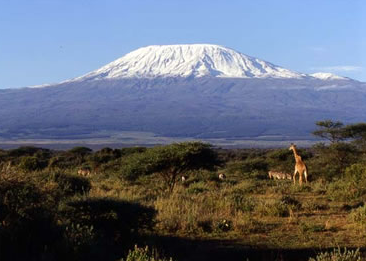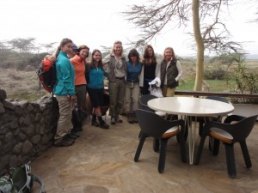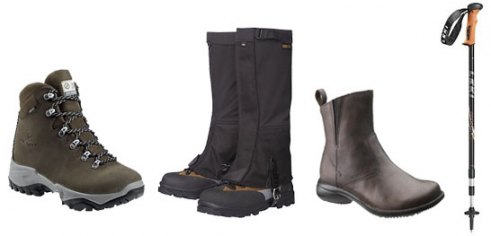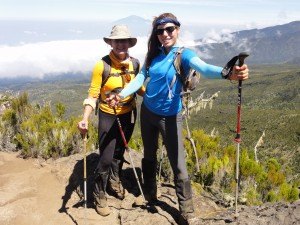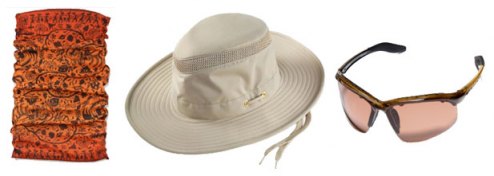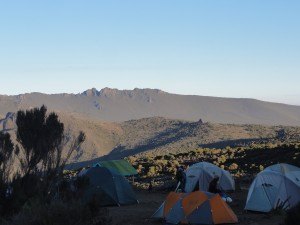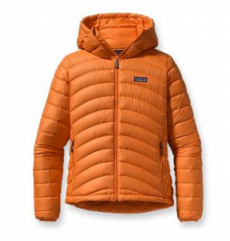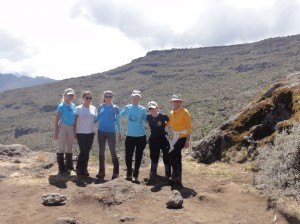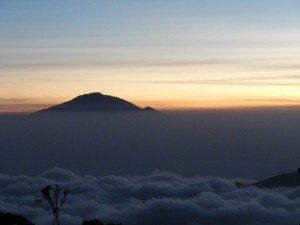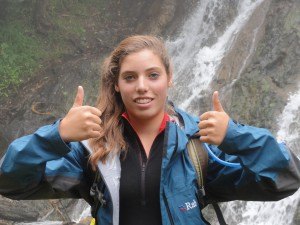Climbing Kilimanjaro
Mount Kilimanjaro, located on the border of Kenya and Tanzania is the tallest freestanding mountain rise in the world,, rising between 18,000 and 19,000’ depending on the source. On the 7 day climb on the Machame Route, we will pass through virtually every ecosystem on earth, including rain forest, moorland, alpine, glacier, and snowfields. For a complete Kilimanjaro Packing List, go to How to Pack for Kilimanjaro. Or for more information, please go to Climbing Kilimanjaro Part 1.
Our group is 8: writer Jane Furse, who organized the trip and is working on an article for The Daily News, her daughter, ZZ Friedman so full of life and taking this opportunity for adventure between Cambridge and Penn Law School, Celeste Rault, my raison d’etre, and the most organized person I know, Lulu Rault, a clever and quick-witted 20 year old college student, dear friend Janna Bullock, who never says ‘no’ to anything, and her lovely daughter Eugenia, BFF with my daughter, Kell.
DAY ONE: Hiking time 7 hours Distance 18 kms. Altitude: From 4890’ to 9777’
After camping for two nights in the Mt. Meru rainforest at 6500’ in order to acclimatize for the altitude, day one finally arrives and we have a set-back. Lulu is terribly sick and cannot possible start the ascent. We are so sad to lose the fabulous Raults. There is a chance they can join us tomorrow so we all hold out for that hope.
We arrive at the Machame Gate to register for the climb, organized by Tim Lapage’s Safari Experts. It is a very efficient paper process and a relief that they are serious about tracking our whereabouts. We set off, up the Machame Route to the Machame Camp, through the Montagne Forest. It is wet from the night’s rain but thankfully, none today. The path, about 5’ wide, is composed of ‘scree’ or fine dirt mixed with stones, bordered by wooden logs. It is beautifully hand constructed and maintained. Because of our late start, we have the trail to ourselves, which we later discovered is a luxury, as most mornings porters and climbers vie for the trail.
From the start, I employ a breathing technique, taught to me by my friends Eric Rosenfeld and Eames Yates, breathing in with each step and out with the next. In training for this climb, I would go for long periods on the treadmill at the highest incline of 15 degrees. In comparison, this walk is about a 20 degree hill. It is damp and wet with mud sloshing up around our legs. The poles come in handy for picking your way through the scree but the absolute must stars of the day are good hiking boots and gators.
Day 1 Essentials
Left to Right: Scarpa Women’s Luna GTX Boot ($169), Outdoor Research Women’s Crocodiles Gaiters ($69), Merrell Tetra Catch Waterproof Hiking Boot ($124.95), Leki Summit Antishock Trekking Poles ($99.95)
Lunch is in a glade at the side of the path with all sorts of fresh fruits and vegetables. The selection is always varied and plentiful. Then it is back to the climb, another 4 hours to reach the Machame Camp. It is almost nightfall when we arrive and the temperature has dropped considerably. After an introduction to our Porters, we climb into our tents to change out of our wet clothing and put on the clean clothes that we will wear the next day. Because of the cold, we ‘crashed’ the cook’s tent with all burners on high in preparation for our long-awaited dinner. It was delightful sitting with the our new friends, amidst delicious smells and the warmth of the stoves. Every evening at dinner, we are checked for oxygen level and heart rate. It has become a competition to see who has the highest level and the lowest rate.
DAY TWO: Hiking time 6 hours Distance 9 kms, Altitude 9777’ to 12,600’
Day two, we wake to a beautiful morning, chilly but sunny and look forward to the climb ahead. It is a more difficult hike than the previous day through the Moreland terrain. The incline increases to 25 to 30 degrees. Instead of small rocks and scree, much of our day is spent navigating uphill through larger rocks, picking our footing wisely. I am remembering my trainer Ray Gonsalves’ fitting advice: “Lift with you’re gluteus maximus, not with your knees.” The dryness of the sun is making it hot and dusty and we are merrily but slowly making our way, happy for the first bit of sunshine in several days. The mantra is heard again and again, “poley, poley, poley” (slowly, slowly, slowly). I am in love with my Bandana Neck Gator for it’s ability to act as a dust mask as well as a brow mopper, my Tilley Hat to shield my face and a great pair of polarized sunglasses.
Day 2 Essentials
Left to Right: Buff Original Bandana ($20), Tilley LTM6 Airflo Hat ($77), Native Eyewear Hardtop XP Polarized Sunglasses ($129)
We arrived in late afternoon, with time to sponge off with hot water and soap, delivered to our tent door. It felt divine to remove the stubborn, reddish scree from everywhere. The porters had gone ahead and set up camp, complete with our personal 2 man tents, 2 loo tents, a cook tent and a dining tent. Little napping, note taking and off to dinner where we are always briefed by our Head Expedition Leader, Bonaventure on the next day’s plan. Great comraderie and talk of “The Summit.” It is 5 days away, and as I am having some difficulty breathing, I wonder if I will be part of it. On our way to the tents, we were treated to another breathtakingly beautiful, black and showy sky.
Must-have in camp at night and climbing in the freezing temperature.
Patagonia Women’s Down Sweater Full-Zip Hoody ($250)
DAY THREE: Hiking time: 7 hours, Distance 15 km, Altitude 12,600’ – 15,190’
As we take off on the climb, I am having a hard time catching my breath. My breathing technique is not working as it was on the previous days. Every 10 steps or so, I am forced to stop and catch my breath. How am I ever going to make it to the summit?
I mentioned to Bonaventure that I was struggling and worried that I will hold the group up on the ascent today. As I learned on the first day, it is key to arrive at camp while there are a few hours of daylight. Otherwise, the camp is cold, unfamiliar and unwelcoming. As the group gathered, we had to assess the situation and make a quick decision. I was not ready to quit but we were at a juncture where turning back was still possible. If I went on for another day, it would be much more difficult. I was thinking of Kell, what would she do? I did not want her to feel abandoned on the mountain with the most difficult days ahead. “I will stay” she declared, and the group cheered. At this point, Bonaventure wisely suggested that he test my oxygen level, which revealed a abnormally low heart rate – so low, that the decision was made for me. I would go down.
We had to get the party ascending as quickly as possible so there were brief goodbyes. I picked up my backpack to follow my porter and turned to look back uphill – they were gone. It was about a 2 hour hike to the Ranger Station and I had time to think. From the start, the climb was hard and cold, perhaps too much for me. Descending I felt sad. It was the end of this particular adventure which had been planned for months and months.
Why Kilimanjaro?
It is the question that everyone asks and I wasn’t sure I knew the answer. It was true that this highly organized, mother-daughter trip landed on my lap at a “Bhutan Girls” reunion dinner last spring and that I was very fond of all of the ‘Kili Girls” but there had to be more to it than that.
Many years ago, I was a young documentary film producer working with friend Bob Nixon, the Emmy Award winner who had just left ABC’s American Sportsman. With Bob’s contacts and my organizational skills, we began producing films on wildlife and conservation. It is interesting to note that this was well before the Nature Channel aired. In the years between 1985 and 1988, we had many projects in Africa, including With Peter Beard for ABC Television and The Making of Gorillas in the Mist for Universal Pictures. Those years coincided exactly with the creative project of another type, the birth of my two sons Adam in 1986 and Jake in 1987. Being either pregnant or nursing or both, I was unable to go on location, nor did I want to leave my babies. Years later we took our grown and beautiful family on Safari in South Africa. It was the most wonderful, memorable trip imaginable. They say Africa changes you, and it does but perhaps I was still seeking a more rugged African Adventure.
But the real answer to “Why?” lies in my daughter of 15, Kell. Born and bred in New York City, with all the entitled trimmings, what could be a more perfect bonding experience?! We will be fellow sportsmen, comrades in arms, just imagine the esprit de corps! As my wry son Adam, now 25, observed, “I wouldn’t overplay the bonding thing.” Right okay – great advice.
As I sit in the Land Rover waiting to descend, leaving my precious Kell on the mountain with friends, I am overwhelmed with admiration for her. I have learned that she is unflappable under pressure, that her smile lights up a tent, that she is a great and generous friend, and that she is braver than I will ever be. Wasn’t that the point of the trip?
Karen Klopp
August 1, 2011
Postscript
On the last night, the climbers are woken at midnight to complete the 8 hour climb to reach the Uhuru Peak. It is a dark and difficult with freezing temperatures and little oxygen. Three hours into it, Kell cannot go on. Janna and Eugenia Bullock, Jane Furse and ZZ Friedman completed the ascent to Uhuru Peak on Wednesday, August 3, 2011.
Our Crew – 61 Men
Head Expedition Leader – 1 Bonaventure, Assistant Expedition Leader – 1 Mahil, Head Guides – 2 Bonaface & Nelson, Assistant Guide – 1 Loic, Chef – 1 Dayo, Assistant Chefs – 2 Roderick & Rashide, Porters – 49, Loo Crew – 2 Richard & Illysa, Camp Crew – 2 Nixon & Stones
The Porters
You hear stories of porters running, barefoot up the mountain carrying incredible heavy packs. Except for the heavy part, this is a myth. These men struggle with every step they take under enormous weight. Most are ill-clothed and shod. To a man, they are completely committed to their responsibilities for the safety and comfort of the party. The guides and the porters are heros in this colossal effort.

